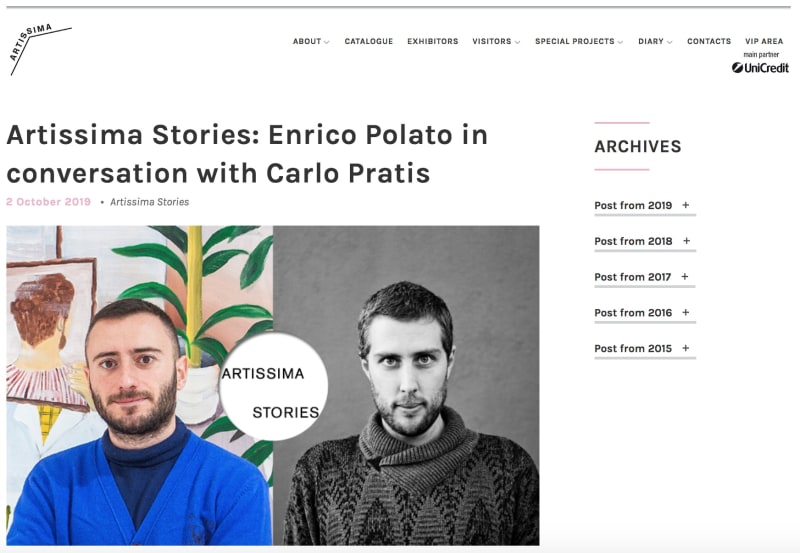Enrico Polato of Capsule Shanghai and Carlo Pratis of Operativa Arte Contemporanea in Rome reflect on their gallery model, their work with emerging artists, their relationship with art fairs, and the upcoming Artissima.
Enrico Polato: When I decided to open Capsule in Shanghai, I wanted to present artists at the beginning of their careers, and I've been working to build strong, lasting collaborations that will allow me to grow professionally along with my artists. Up to now I've given more room to solo shows than to group exhibitions. I think they're the best way to introduce the work of an emerging artist. Shanghai has become a very important art hub in recent years, with many private museums and international galleries arriving on the scene. The change has been quite rapid, so it's an ecosystem that's still evolving. But still, I can sense that a system of patronage for emerging art is starting to develop, and I'm very optimistic that it will mature over time and with a younger generation of collectors.
Carlo Pratis: The model I've tried to pursue in these years of work with Operativa is that of a young, non-commercial gallery dedicated to experimentation, totally alien to any profit-geared approach that might undermine the freedom of expression I think artists need when they're just starting out. It's the kind of project that immediately takes artists' work outside the gallery walls, supporting them above all through shows in public spaces and museums in Italy and abroad.
EP: I opened Capsule in October 2016. My first fair was West Bund in Shanghai in 2017. Later on came Art Basel Hong Kong, Beijing Contemporary, Art Shenzhen, Frieze NY, Paris Internationale and Artissima. I recognize the importance of art fairs, which have helped me make invaluable contacts in the past. I think of fairs as a temporary extension of the gallery space, so I find it useful to be in fairs outside of China as a way of promoting my artists abroad. But fairs also make a big dent in the gallery's annual budget. After some rash decisions in the past, I've learned to be more selective. At the moment I'm prioritizing fairs that offer sections specifically conceived for young galleries, at a slightly lower cost, which makes it easier for me to attend and minimizes the risk.
CP: I think it's important to take part in Italian fairs and put our energy into bolstering a national art system that has an identity of its own: hopefully more and more independent, but with an international outlook, like the one Artissima is gradually creating. For this edition we'll be presenting a double solo show by Matteo Nasini and Emiliano Maggi, a tribute to the dream worlds of Alberto Savinio.
EP: Artissima has always been on my radar. It's a fair with an outstanding reputation. Living in China for the last sixteen years, I've developed my professional expertise away from Italy. I can say with a hint of pride that I think the time has come to forge stronger ties to my home country, and present my artists to the world starting with the place where I have my roots. I hope a fair like Artissima will let me get the most out of the experience and start up a dialogue between my gallery and Italy. This year I'll be presenting Wang Haiyang, a Chinese experimental video artist and painter. The installation, Skins, includes a video animation and a series of pastels portraying hybrid creatures, with human lineaments but covered in fur like primates. These portraits, which are of striking technical quality, explore human behavior like addiction, fetishism, vanity, violence… they erode the boundaries that determine the acceptability of certain norms of behavior. I think it's a project with a compelling emotional charge, in keeping with the "desire/censorship" theme of Artissima 2019.
CP: Artissima has unquestionably helped me find new collectors and put me in touch with curators I wouldn't have otherwise met. My first time there, a young French curator literally fell in love with Matteo Nasini's solo stand. And so now Nasini has been featured in various museum shows abroad, including one that's still up at the marvelous Fontfroide Abbey in the south of France.


